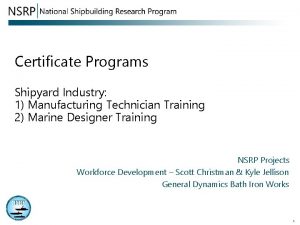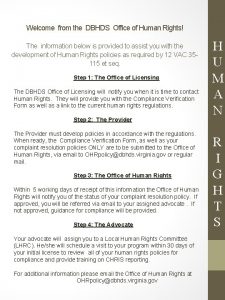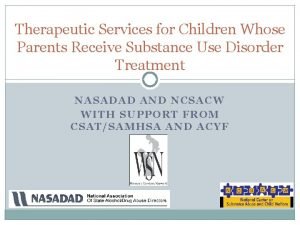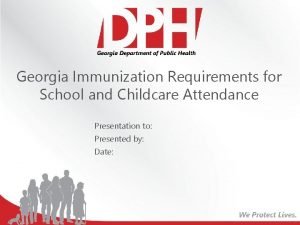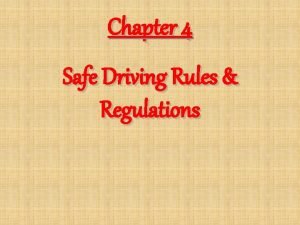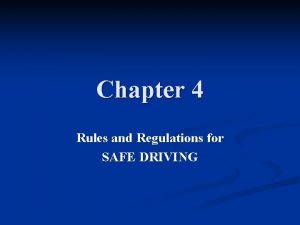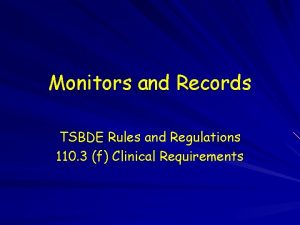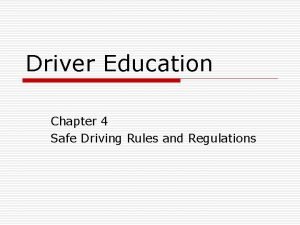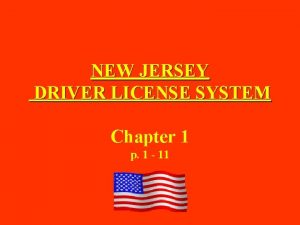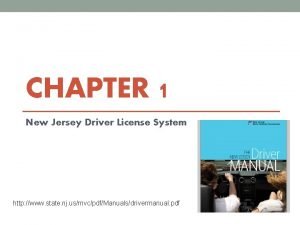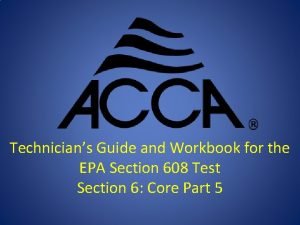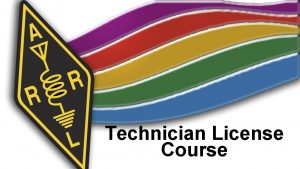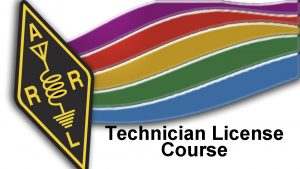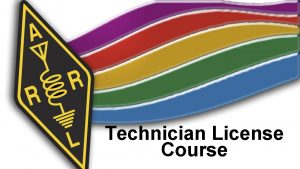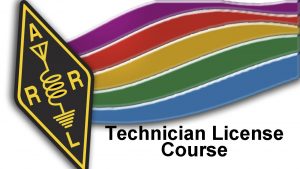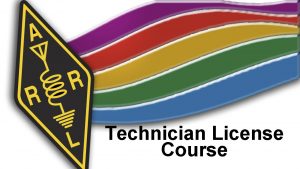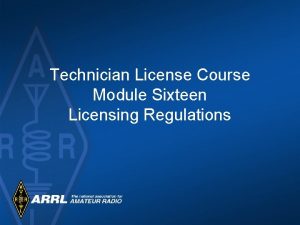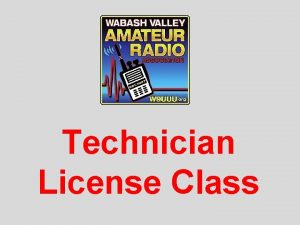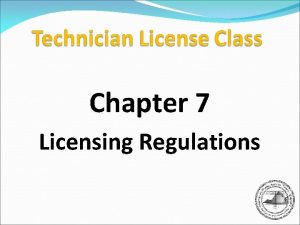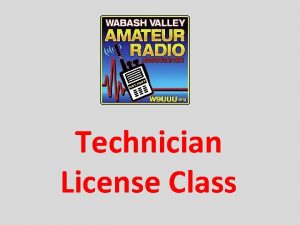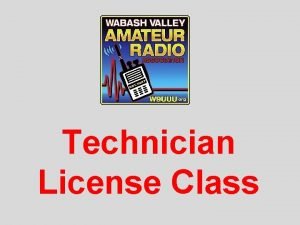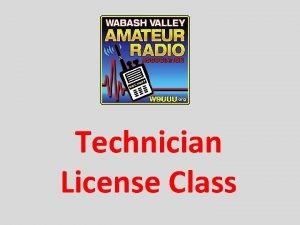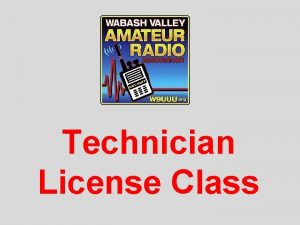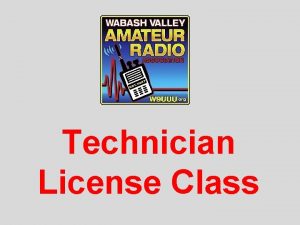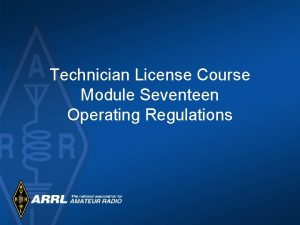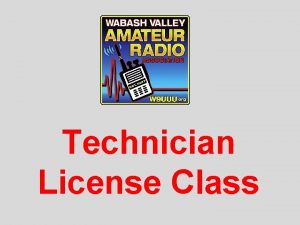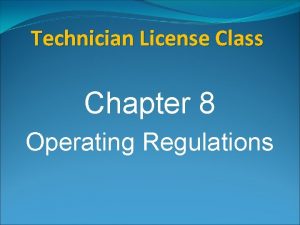Technician License Course Chapter 5 Licensing Regulations Licensing

















- Slides: 17

Technician License Course Chapter 5 Licensing Regulations

Licensing Authority • Federal Communications Commission – Located in Gettysburg, PA. • Amateur Radio operations covered by FCC rules published in Part 97 of Title 47 – Code of Federal Regulations. – Use Part 97 for short

Why is There Ham Radio? 1. Providing emergency communication capability. 2. Advancement of the art and science of radio. 3. Advance communication and technical skills of radio. 4. Provide a trained reservoir of operators, technicians, and electronics experts. 5. Promote and enhance international goodwill.

Some Definitions • Amateur Service – no pecuniary interest (private and personal, non commercial). • Amateur Operator – the person holding authorization (license) to operate an Amateur Radio station. • Amateur Station – equipment capable of transmitting on frequencies authorized for Amateur Service.

The Amateur License • No age limit or citizenship restrictions. – One exception – foreign representatives. • License actually contains two parts. – Operator License. – Station License (the Call Sign). • Three levels of operator privileges: Technician, General, Amateur Extra.

Examinations • Preparation – Study the content. – Question Pool. • Taking the exam – Proctored exam. – Multiple choice. – What the fee pays for. • Volunteer Examiners (VEs). • Volunteer Examiner Coordinators (VECs).

License Term and Renewal • The license is free and good for 10 years. – Renewable within 90 days of the expiration date. • Some personal identification information is required. – Tax ID (Social Security number). – Current Mailing Address. – Federal Registration Number (FRN).

Responsibilities of Licensure • Prevent unauthorized operation of your station. • Provide personal information as required – keep a current mailing address on file. • Make your station available for FCC inspection upon request.

FCC ULS Web Site • www. wireless. fcc. gov/uls – Register for on-line access to your license information. – Make changes to your address and other information. – Renew your license. – Search for other station information.

What can you do with a Technician Class License? • Frequency Privileges: – Band versus frequency.

What can you do with a Technician Class License? • Emission Privileges:

What can you do with a Technician Class License? • Power limits. • Use the minimum power required to get the job done. • Up to 1500 watts peak envelope power (PEP). – Will generally require an external amplifier to achieve these power levels. • Some special cases where power is restricted.

Primary and Secondary Allocations • Some authorized amateur frequencies are shared. – Primary Users. – Secondary Users.

Amateur Radio - Internationally • International Telecommunication Union (ITU). – Regions 1, 2 and 3. • CONUS hams are in Region 2. • Reciprocal operating authorizations. • There are times when there are restrictions on certain countries that we can contact.

Call Signs • US call signs begin with: K, N, W, and A. • US call sign districts: 0 -9

Call Signs • Portable – operating away from primary station location. • If in the different call sign district add: – “portable 6” if voice. – /6 if Morse code or digital. – Not required, just nice to do. • If recent upgrade add “AG” or “AE. ”

Special Call Signs • Club and special event call signs. • Vanity call signs.
 Manufacturing technician license
Manufacturing technician license Manufacturing technician license
Manufacturing technician license Dbhds office of licensing
Dbhds office of licensing Georgia child care licensing regulations
Georgia child care licensing regulations Ga form 3231 blank
Ga form 3231 blank T junction of stretcher bond
T junction of stretcher bond Course number and title
Course number and title Course interne moyenne externe
Course interne moyenne externe Center line font
Center line font Chapter 4 safe driving rules and regulations
Chapter 4 safe driving rules and regulations Chapter 4 safe driving rules and regulations
Chapter 4 safe driving rules and regulations Head tilt chin lift and jaw thrust maneuver is used for
Head tilt chin lift and jaw thrust maneuver is used for Controlled uncontrolled and blind intersections
Controlled uncontrolled and blind intersections Altering a license may result in
Altering a license may result in Chapter 1 the new jersey driver license system answers
Chapter 1 the new jersey driver license system answers Chapter 1 the new jersey driver license system answers
Chapter 1 the new jersey driver license system answers When preparing an iv solution a technician should work
When preparing an iv solution a technician should work How long must a technician evacuating refrigerant
How long must a technician evacuating refrigerant
